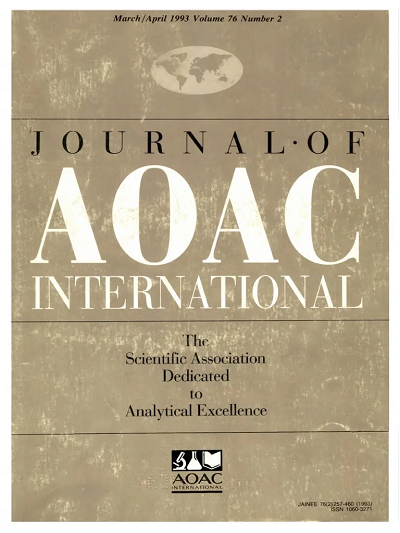使用不同消毒剂对虾池水进行细菌灭活研究
IF 1.7
4区 农林科学
Q3 CHEMISTRY, ANALYTICAL
引用次数: 0
摘要
背景 水产养殖用水在对虾收获过程中抗生素耐药细菌的传播中起着重要作用。通过排放减少细菌对防止向下游传播至关重要。与其他细菌灭活方法相比,对养殖水进行化学消毒是可行的。目标 研究不同消毒剂的效果,即氯气、Fenton's 反应、方法 将水样用不同浓度的氯(0.0、1.0、2.5、5.0 和 10.0 mg L-1)、芬顿试剂(Fe2+:H2O2 的比例为 1:10 mM;2:20、3:30、4:40、5:50)和 H2O2(20、30、40 和 50 mM)处理不同时间(5 分钟、15 分钟、30 分钟和 60 分钟)。结果 结果表明,随着浓度和时间的增加,所有消毒剂都能灭活全部异养菌和四环素耐药菌。在使用氯化(2.5 mg Cl2 L-1)、芬顿试剂(2 mM Fe2+ + 20 mM H2O2)和 H2O2(50 mM H2O2)处理 60 分钟后,水样中的总异养细菌数分别比初始细菌数逐渐减少了 2.35、2.65 和 1.38 log10 CFU mL-1,耐四环素细菌数分别减少了 1.57、1.66 和 1.43 log10 CFU mL-1。结论 研究表明,消毒剂可成功用于灭活养殖水体中排出的抗生素耐药菌。在三种消毒剂中,芬顿试剂能有效抑制水样中的异养菌和耐四环素细菌。要点 使用氯化、芬顿试剂和过氧化氢进行了细菌灭活研究。在使用芬顿试剂处理的水样中,HPC(2.65 log)和耐四环素细菌(1.66 log)的降幅最大。使用消毒剂可有效减少水产养殖废水中的抗生素耐药菌。本文章由计算机程序翻译,如有差异,请以英文原文为准。
Bacterial Inactivation Studies in Shrimp Pond Water by using Different Disinfectant Agents
Background Aquaculture water plays an important role in the dissemination of antibiotic-resistant bacteria during harvest of shrimps. Mitigation of bacteria through discharge is essential to prevent dissemination downstream. Chemical disinfection of culture water is feasible compared to other methods of bacterial inactivation. Objective To study the effect of different disinfectant agent’s viz., chlorine, Fenton’s reagent, and hydrogen peroxide (H2O2) on inactivation of bacteria from shrimp pond water Methods The water samples were subjected to treatment with various concentrations of chlorine (0.0, 1.0, 2.5, 5.0 and 10.0 mg L−1), Fenton’s reagent (1:10 mM ratio of Fe2+:H2O2; 2:20, 3:30, 4:40, 5:50) and H2O2 (20, 30, 40 and 50 mM) for different time durations (5 min, 15 min, 30 min and 60 min). Results The results indicated that all the disinfecting agents inactivated both the total heterotrophic bacteria and tetracycline-resistant bacteria with increased concentrations and time. At the end of 60 min treatment with chlorination (2.5 mg Cl2 L−1), Fenton’s reagent (2 mM Fe2+ + 20 mM H2O2) and H2O2 (50 mM H2O2), the total heterotrophic bacterial count in the water samples gradually decreased by 2.35, 2.65, and 1.38 log10 CFU mL−1, and tetracycline-resistant bacteria count reduced by 1.57, 1.66, and 1.43 log10 CFU mL−1, respectively from initial bacterial load. Conclusions The study revealed that disinfection agents can be successfully employed in the inactivation of antibiotic-resistant bacteria discharged through aquaculture water. Among three disinfection agents, Fenton’s reagent has been found effective in inhibiting both heterotrophic bacteria and tetracycline-resistant bacteria from water samples. Highlights Bacterial inactivation studies were carried with Chlorination, Fenton’s reagent, and Hydrogen peroxide. The highest decrease in HPC (2.65 log) and tetracycline-resistant bacterial (1.66 log) was noticed in the water samples treated with Fenton’s reagent. The use of disinfection agents effectively mitigates antibiotic-resistant bacteria from aquaculture wastewater.
求助全文
通过发布文献求助,成功后即可免费获取论文全文。
去求助
来源期刊

Journal of AOAC International
医学-分析化学
CiteScore
3.10
自引率
12.50%
发文量
144
审稿时长
2.7 months
期刊介绍:
The Journal of AOAC INTERNATIONAL publishes the latest in basic and applied research in analytical sciences related to foods, drugs, agriculture, the environment, and more. The Journal is the method researchers'' forum for exchanging information and keeping informed of new technology and techniques pertinent to regulatory agencies and regulated industries.
 求助内容:
求助内容: 应助结果提醒方式:
应助结果提醒方式:


